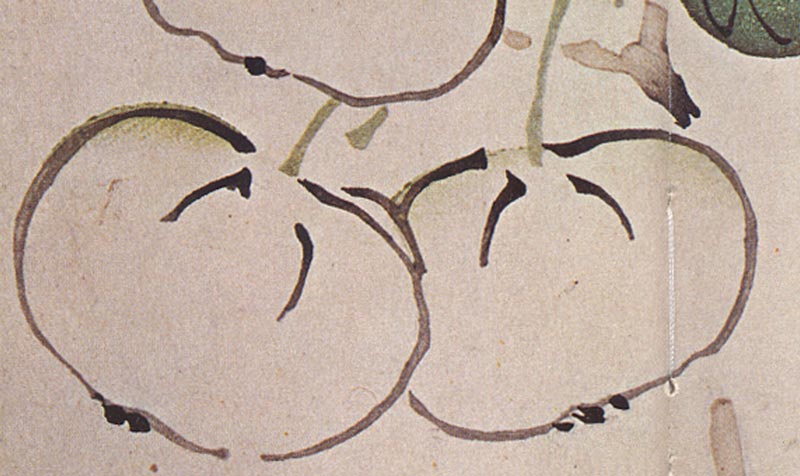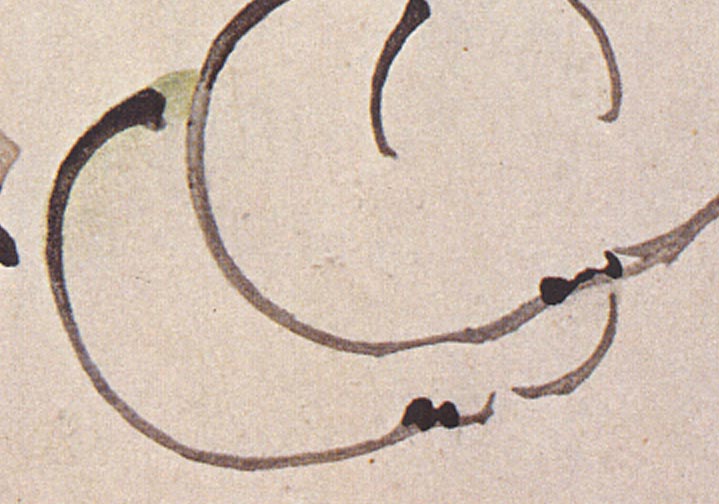Posted by Dave Bull at 2:24 AM, September 15, 2011 [Permalink]
This morning, just in time for lunch, I finished up printing on the first batch (120 sheets) of the current Mystique print - the design from the old Chinese book 'Ten Bamboo Studio'.
All during the work over the past week or so, I have kept a copy of the original print (from back around 1640 or so) by the side of the bench. I don't own one of course, I'm referring to the image published in a reproduction volume a few years back (clickable):

The text accompanying the image refers to the print as being 'unfinished', and it certainly seems to be, as the fruits are all uncoloured. In my own copy of the book that we saw earlier, these fruits are coloured (albeit clumsily) so it does seem as though the original intent of the designers/craftsmen was to depict them basically naturally.
Another theory for their unfinished appearance though, is that the colours as originally printed might simply have faded. We know that in both China and Japan, artists/printmakers in those days used many pigments that we would not consider 'lightfast'. Perhaps the colour in this case was particularly fugitive, and has disappeared.
If you look closely at the fruit, you can see a faint trace of left-over pigment in a few places:

... and ...

So is this a hint? Perhaps they were printed in a light green, which has faded.
But this doesn't make sense, in the light of the fact that there is so much green still visible in other areas of the print. It can't have been all that fugitive!
So there is the mystery. Faded? Designed this way? Unfinished? If so, then why?
Well, a light bulb went on over my head suddenly this morning when I was looking at this image, and I think I have it all figured out.
I'll post about it tomorrow, but in the meantime, hands up (and leave a comment, of course) from anybody else who would like to have a stab at the answer ... which - once you see it - is totally obvious! (Although that's only easy for me to say now, after staring at this thing for a week! )
Hmmm, a couple guesses - both of which may be totally wrong! I'll be interested to hear your thoughts! First - the artist could have used a different green pigment - I've seen an article talking about differential fading in (if I recall correctly) Cezanne's work where because he used several different greens for different effects, some faded, some didn't. Second, the traces left could be shading and a fugitive red/ or yellow could have been used over top - rose madder (red) or gamboge (yellow) could fade like this...but I'm not sure which pigments were used during the 1600s in China...
Cheers,
Lee

light green is often used as an underlayment for flesh colors so maybe it was used this way to make the color appear more peachy..
As good an idea as any
Barbara

Looks to me like the green traces belong to the green blocks and as Barbara says they might serve to darken an overlaying colour - say pink. But I am not sure that overprinting colours was a technique used back in the day. From the look of the seal in the bottom left corner the red ink seems to be smudged - perhaps spread from washing. If the print has been washed at some stage, which was common practice by some dealers, a delicate pink may have been washed away rather than fading.

"The collection was directed to friends of the arts of painting, poetry and writing. Two volumes contain painting instructions."
Could this be it? It's from an unfinished coloring book ?
Taken from this link.

Ok, one more reference to how-to instructions:
"The manuals give instruction on how to paint common elements found in Chinese paintings: garden rocks, fruit, bamboo, grass, flower blossoms, birds. For example, the lesson on birds shows how to first paint the beak, then the head, body, wing feathers and lastly the feet attached to a branch."
"The manuals provide scholars not only with information on how a painting was created at the time, but also show woodblock examples. Those are works of art in themselves and are much different from Chinese painting."
So there you are, I think this image is one of a set of step-by-step instructions were only the branches and the leaves have been completed...





